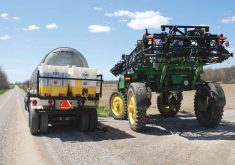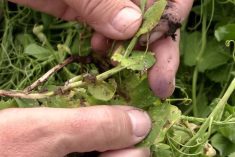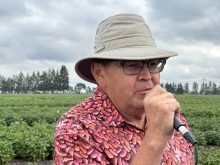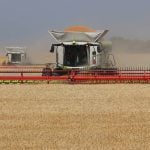Could Manitoba see 300,000 acres of peas a year?
That was the self-admittedly provocative question Manitoba Agriculture pulse extension Terry Buss raised at a March 20 pea producers’ meeting in Brandon.
Hitting that mark would mean an acreage five times larger than this coming season’s projected acreage, which has been pegged at 65,000 acres, up slightly from last year. That figure is still half of that two years ago in the summer of 2016, when StatsCan says 158,000 acres of the crop were harvested.
Pea acres would have to jump almost five times their projections this year before reaching that mark.

“Long term, the line in terms of acres and production is going up,” Buss said. “The local processing and western Canadian processing is going to continue to drive that and that’s going to be filled with a number of new growers coming into it. Those people need, sort of, this introduction to the crop. What we’ve found is the weather has fought against us in terms of success and failure, but there are things we can do to ensure a more stable and higher yield year to year.”
Variable crop
Field peas are well known as a “see-saw” crop sensitive to extra moisture, a challenge for producers who, until last year, have been caught in a wet cycle through much of the province. Buss noted weather easily tips the scales between boom and bust, particularly in heavier, less drained soils.
Read Also
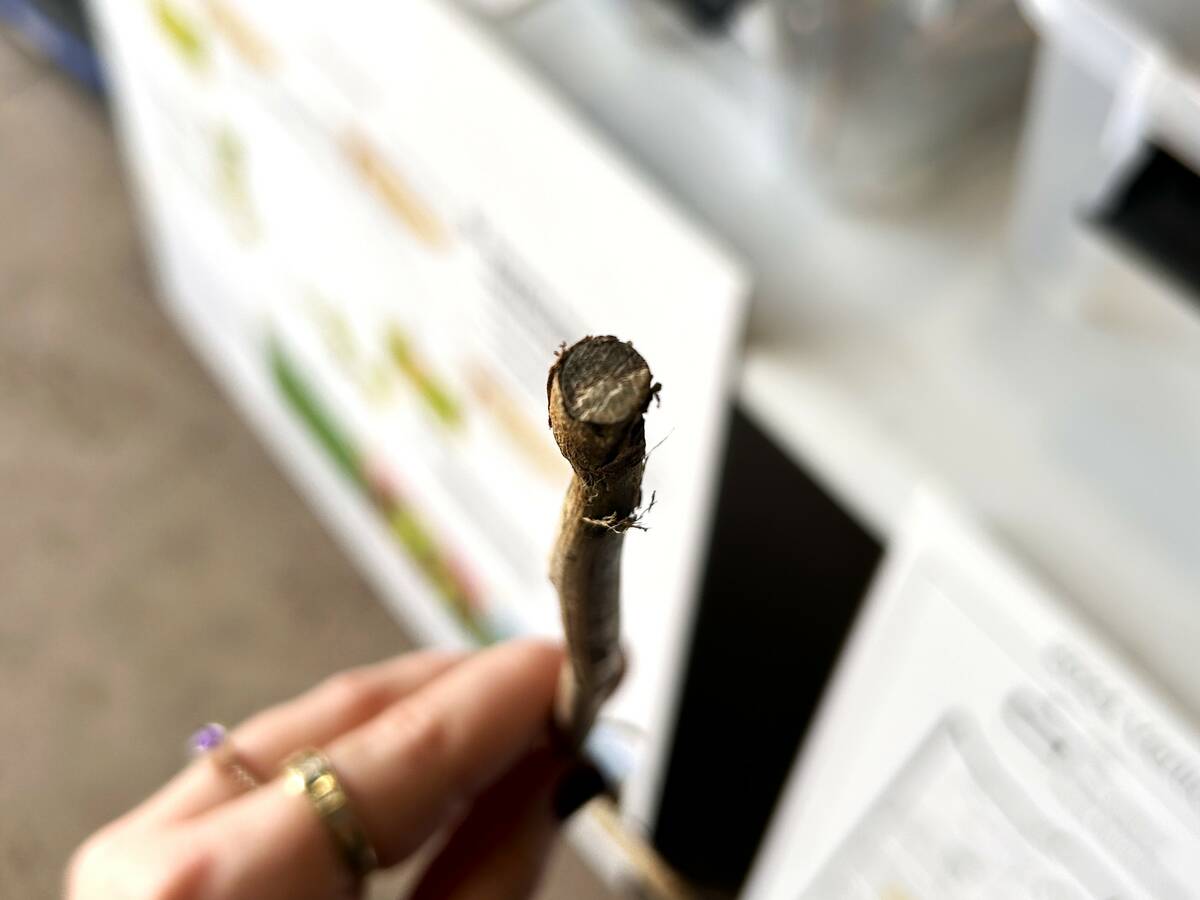
Manitoba canola embattled by verticillium
Verticillium stripe pressure has been growing in Manitoba, and canola farmers still have precious few tools to protect their crop from the disease.
Last year was a fight in the market, but a bumper year in the field. The same dry weather that stymied soybeans gave a significant boost to peas. Yield hit an average 53.1 bushels an acre, according to Yield Manitoba, well above 37.4 bushels an acre the year before.
Fields that would normally be too heavy and waterlogged produced abnormally well, Buss said, to the point that he warned producers not to take last year as a true indication of a field’s suitability for peas.
Field choice will have a lot to do with success, Buss says.
Peas have not been the pulse of choice when compared to soybeans, a crop that hit 2.3 million acres last year and has enticed farmers with more consistent results and greater profit margins.
Buss worries that same rapid expansion has put soybeans on fields less agronomically suited for them in western Manitoba, while robbing field peas of acres they’re more suited to.
Suitability may be more field specific than region specific, he added, noting that even some fields in the typically heavy clay of his home RM of Brokenhead may turn up sandy and suited for peas.
Getting started
A good launch is also critical for a crop that is not competitive with weeds until the canopy closes, Buss stressed.
Standing research out of Alberta suggests that weed control a week after emergence produces the same yields as a weed-free plot. After three weeks, however, yield dropped to 88 per cent of the weed-free plot.
Manitoba Agriculture sets ideal early stand density at 7.1 to 8.1 plants per square foot, although a field with five to six plants in the same area may still yield well if it is uniform and weeds are kept in control.
Unlike soybeans, a crop where farmers are usually told to hold off until soil temperature reaches 10 C, early seeding is often a boon for field peas. Early seeding may dodge heat blast problems at flower, Buss said, pointing to MASC data showing a downwards yield trend in fields planted after May 1.
Seed quality may also make the difference between success and failure, he noted. Soybean seed may be fragile, he said, but field peas are even more so and he encourages pea growers to check for cracks.
“I think there’s a range of grower expertise and grower experience,” he said. “We have individuals in the province who have grown field peas for quite some time who have had acres over decades and those individuals are fairly well experienced. Some of them actually grew peas when we didn’t have the tools that we have even now, especially on the weed control side. It was even tougher. But we’re seeing a lot of new entrants into the business.”
Challenges
Pea growers may have had a bumper year for yield, but a bleak market makes the crop a hard sell for farmers looking to balance their books this season.
The bottom fell out of field pea prices late last year as trade issues with India, Canada’s largest market for field peas, came to a head.
Trouble started in October, when Canada lost its exemption to ship pulses to India without fumigating with methyl bromide, a gas known to deplete ozone and so restricted or banned in multiple countries.
More bad news came a little over a month later. India introduced a 50 per cent duty on peas, later adding duties to lentils and chickpeas as well.
Pulse Canada has pointed to a wealth of domestic factors for India’s new hardline policy. The country is dealing with oversupply after a bumper pulse crop, Pulse Canada says. Added to that, Indian politicians are courting the rural vote ahead of 2019 elections and have put a new focus on the mandate to deal with food security within their own borders.

Roquette reassures
Trade issues have turned even more eyes towards Roquette and its incoming pea protein plant near Portage la Prairie. The company has drawn a huge amount of attention with its promised 125,000-tonne facility, to be opened next year.
The company stresses it’s forging a new path that could offset some of the impact of the India situation for local growers. It’s producing protein to be used in food products and other processes, rather than unprocessed peas that would depend on that market, said John Buch, Roquette America risk department manager.
“The protein market’s a very exciting market,” Buch said. He noted the company doesn’t welcome the prospect of price volatility for raw ingredients but also noted it would be manageable.
“The challenges that people are faced with, I think having a market here locally will help them and they will know that Roquette’s here and that they’ll have a place to sell their peas to regardless of foreign trade regulations and those types of things.”
Buch added that the company has been in touch with seed growers in the lead-up to that first season.
Roquette expects some contracts to go out for peas this year, although main contracting will take place in 2019.
Production hurdles
Disease pressures throw another wrench into any effort to bring field peas up to 300,000 acres.
Holly Derksen, Manitoba Agriculture plant pathologist, said rotations must be longer to grow pea acres sustainably and producers must start thinking about preventive, not just curative disease control.
Root rots limit peas for anything tighter than a three-year rotation. For fields positive for aphanomyces, that jumps to one year in six. Longer rotations are the only consistent method for dealing with the dreaded water mould, Derksen said.
“Our major concern is aphanomyces, the root rot, because it (survives) so long within the soil and we know it can cause major yield loss,” she said. “Mycosphaerella, which is obviously a very common foliar disease, can be somewhat easily managed with fungicide as long as you can get in there at the right timing.”
Mycosphaerella is endemic in Manitoba, Derksen said. The Manitoba disease survey consistently finds the pathogen in every field surveyed, although severity varies.
Aphids are another problem, one that farmers across the province were fighting last year. The pest commonly begins on legume or perennial alfalfa before moving on to peas, Buss said.

Farmers may want to spray in years where scouting shows more than two to three aphids per 20-centimetre plant tip or nine to 12 insects per sweep at flowering, but they may also need to hold off to get the most use out of insecticide.
Scouting should be done at 50 to 75 per cent flower, Buss said, but insecticide will be more effective when half of the plants start producing pods.
Buss didn’t shy away from the crop’s challenges. In particular, he noted, trade with India needs to be restored.
At the same time, he maintained that pea popularity has swung before and that market pressures may even out in time.
“I think once these plants are up and running we’re going to see increasing demand,” he said. “I think that demand is going to be competitively priced as opposed to export demand. I think that those processors will have certain levels of quality and things that they need and I think that there’s going to be growers who are very successful meeting that for them. Long term in the international market, I think things are going to start working their way back to where we were before.”







